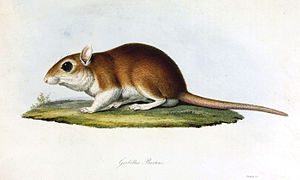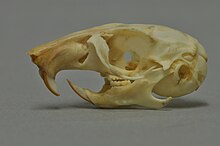Real gerbils
| Real gerbils | ||||||||||||
|---|---|---|---|---|---|---|---|---|---|---|---|---|

Burton's gerbil ( Gerbillus burtoni ) |
||||||||||||
| Systematics | ||||||||||||
|
||||||||||||
| Scientific name | ||||||||||||
| Gerbillus | ||||||||||||
| Desmarest , 1804 |
The real gerbils ( Gerbillus ) are a genus of rodents from the group of gerbils (Gerbillinae). The approximately 60 species of this genus live in northern and eastern Africa as well as in southwest and southern Asia .
description
Real gerbils reach a head body length of 5 to 13 centimeters, a tail length of 7 to 18 centimeters and a weight of 10 to 63 grams. Their fur is yellow-gray or reddish in color on the upper side, the flanks are lighter and the belly is whitish. The tail is hairy throughout and usually has a small tassel at the end. They have the elongated hind legs typical of gerbils and the body is slender. The elongated ears and claws are striking.
Way of life
Real gerbils live in dry areas with sandy or rocky subsoil with often little vegetation. They are crepuscular or nocturnal, during the day they retreat to self-built structures. These can be two to three meters long and have a nest padded with plants, they are also used to store food supplies. Several animals dig their burrows in the immediate vicinity of the neighboring burrows, giving the appearance of large colonies. The diet of the real gerbil consists of seeds, roots, nuts, grass and occasionally insects.
After a gestation period of around 20 to 22 days, the female gives birth to one to eight (on average four to five) young animals. They are naked and blind at birth, open their eyes at around 16 to 20 days and are weaned at one month.
Real gerbils and humans

Some species of the real gerbil are popular as pets , including the small Egyptian gerbil ( Gerbillus gerbillus ), the great Egyptian gerbil ( Gerbillus pyramidum ), the pale gerbil ( Gerbillus perpallidus ) or the Baluchistan gerbil ( Gerbillus nanus ).
Many species, on the other hand, are considered threatened due to their small distribution area. In addition, the exact range of many species and the delimitation of individual species from one another is unknown. More than 20 species are therefore listed by the IUCN under “ data deficient ” .
Systematics
Real gerbils are divided into three sub-genera, Handecapleura , Dipodillus and Gerbillus . Dipodillus can be recognized by its noticeably short tail and short hind legs, the animals of the subgenus Handecapleura and Gerbillus differ in the hairless soles of the feet.
There is disagreement about the number of species, it varies from 40 to 60. The following list follows Wilson & Reeder.
Subgenus Handecapleura
- The Giza gerbil ( Gerbillus amoenus ) is common in Egypt and Libya .
- The Botta gerbil ( Gerbillus bottai ) lives in Sudan and Kenya .
- The Brockman gerbil ( Gerbillus brockmani ) is endemic to Somalia .
- The North African gerbil ( Gerbillus campestris ) is distributed throughout North Africa (from Morocco to Sudan).
- The Wagner gerbil ( Gerbillus dasyurus ) lives in the Middle East and on the Arabian Peninsula .
- Gerbillus diminutus isendemicto Kenya .
- The black tassel gerbil ( Gerbillus famulus ) lives exclusively in Yemen .
- The Algerian gerbil ( Gerbillus garamantis ) is native to Algeria .
- The gerbil ( Gerbillus grobbeni ) lives in the Libyan region of Cyrenaica .
- The Harwood gerbil ( Gerbillus harwoodi ) is native to Kenya.
- The henley gerbil ( Gerbillus henleyi ) is common throughout northern Africa and the Arabian Peninsula.
- The James gerbil ( Gerbillus jamesi ) is endemic to Tunisia .
- The Julian gerbil ( Gerbillus juliani ) lives in Somalia.
- The Lowe's gerbil ( Gerbillus lowei ) is only known from one place in Sudan.
- The mackillingin gerbil ( Gerbillus mackillingini ) lives exclusively in southeastern Egypt and the subsequent Sudan.
- The great short-tailed gerbil ( Gerbillus maghrebi ) is only known from one place near the Moroccan city of Fez .
- The Mauritanian gerbil ( Gerbillus mauritaniae ) is endemic to Mauritania .
- The Mesopotamian gerbil ( Gerbillus mesopotamiae ) lives in Iraq and southwestern Iran .
- The Darfur gerbil ( Gerbillus muriculus ) is native to the Darfur region in Western Sudan.
- Despite its name, the Baluchistan gerbil ( Gerbillus nanus ) is found throughout North Africa and Southwest Asia (from Morocco to India ).
- The percival gerbil ( Gerbillus percivali ) is only known from Kenya.
- The great Aden gerbil ( Gerbillus poecilops ) lives in Yemen and southwestern Saudi Arabia .
- Gerbillus principulus is only known from one location in Sudan.
- The gerbil ( Gerbillus pusillus ) is common in Sudan, Ethiopia and Kenya.
- The four-spotted gerbil ( Gerbillus quadrimaculatus ) lives exclusively in northeastern Sudan.
- The little red gerbil ( Gerbillus ruberrimus ) is native to Sudan, Ethiopia and Kenya.
- The Somali gerbil ( Gerbillus somalicus ) lives exclusively in Somalia.
- The Khartoum gerbil ( Gerbillus stigmonyx ) is native to Sudan.
- The sand gerbil ( Gerbillus syrticus ) is only known from Libya.
- Gerbillus vivax also only lives in Libya.
- The Waters gerbil ( Gerbillus watersi ) is known from Somalia and Sudan.
Subgenus Dipodillus
- The small short-tailed gerbil ( Gerbillus simoni ) is common in northeastern Africa (from Algeria to Egypt).
- Gerbillus zakariai is only known from the Kerkenna Islands off the Tunisian coast.
Subgenus Gerbillus
- The Berbera gerbil ( Gerbillus acticola ) is endemic in Somalia and only known from a few localities.
- The agag gerbil ( Gerbillus agag ) is widespread in Africa south of the Sahara (Mauritania to Sudan).
- The Allenby gerbil ( Gerbillus allenbyi ) is only known from the Israeli Mediterranean coast ( Haifa to Gaza ).
- The Anderson gerbil ( Gerbillus andersoni ) lives in the Egyptian Nile Valley .
- The dark gerbil ( Gerbillus aquilus ) is native to southeastern Iran, western Pakistan, and southern Afghanistan .
- The Bonhote gerbil ( Gerbillus bonhotei ) is native to the northeast of the Sinai Peninsula .
- The Burton gerbil ( Gerbillus burtoni ) is known from only one place in the Darfur region and is one of the rarest species.
- The Cheesman gerbil ( Gerbillus cheesmani ) lives all over the Arabian Peninsula and southern Iran.
- The Cosens gerbil ( Gerbillus cosensi ) is only known from Kenya.
- The Dallon gerbil ( Gerbillus dalloni ) lives exclusively in the Tibesti region in Chad .
- The Dongola gerbil ( Gerbillus dongolanus ) is only known from Dongola in Sudan.
- The Somalia gerbil ( Gerbillus dunni ) is common in Ethiopia, Djibouti, and Somalia.
- Flowers gerbil ( Gerbillus floweri ) is only known from the Sinai Peninsula .
- The lesser Egyptian gerbil ( Gerbillus gerbillus ) is common throughout northern Africa.
- The Indian hairy foot gerbil ( Gerbillus gleadowi ) lives in Pakistan and northwestern India.
- Gerbillus hesperidus is native to the Moroccan Atlantic coast.
- The Hoogstraal gerbil ( Gerbillus hoogstraali ) is only known from one location in Morocco.
- The lataste gerbil ( Gerbillus latastei ) lives in Tunisia and Libya.
- The Sudan gerbil ( Gerbillus nancillus ) is native to north-western Sudan.
- The Nigeria gerbil ( Gerbillus nigeriae ) lives in northern Nigeria and Burkina Faso .
- The western gerbil ( Gerbillus occiduus ) is only known from Morocco.
- The pale gerbil ( Gerbillus perpallidus ) lives exclusively in northwestern Egypt.
- Gerbillus pulvinatus ( Syn . : Gerbillus bilensis ) is common in Djibouti , southwest Ethiopia , northwest Kenya and possibly southeast Sudan .
- The great Egyptian gerbil ( Gerbillus pyramidum ) lives in the Nile Valley in Egypt and Northern Sudan.
- The Riggenbach gerbil ( Gerbillus riggenbachi ) is native to the Western Sahara and northern Senegal.
- The Rosalinda gerbil ( Gerbillus rosalinda ) is common in the Kurdufan region in Sudan.
- The Tarabul gerbil ( Gerbillus tarabuli ) lives in Libya.
literature
- Ronald M. Nowak: Walker's Mammals of the World. 2 volumes. 6th edition. Johns Hopkins University Press, Baltimore MD et al. 1999, ISBN 0-8018-5789-9 .
- Don E. Wilson , DeeAnn M. Reeder (Eds.): Mammal Species of the World. A taxonomic and geographic Reference. 2 volumes. 3. Edition. Johns Hopkins University Press, Baltimore MD 2005, ISBN 0-8018-8221-4 .
Individual evidence
- ↑ Gerbillus pulvinatus in the IUCN Red List of Threatened Species 2012.2. Posted by: D. Schlitter, L. Granjon, 2008. Retrieved December 16, 2012 ..